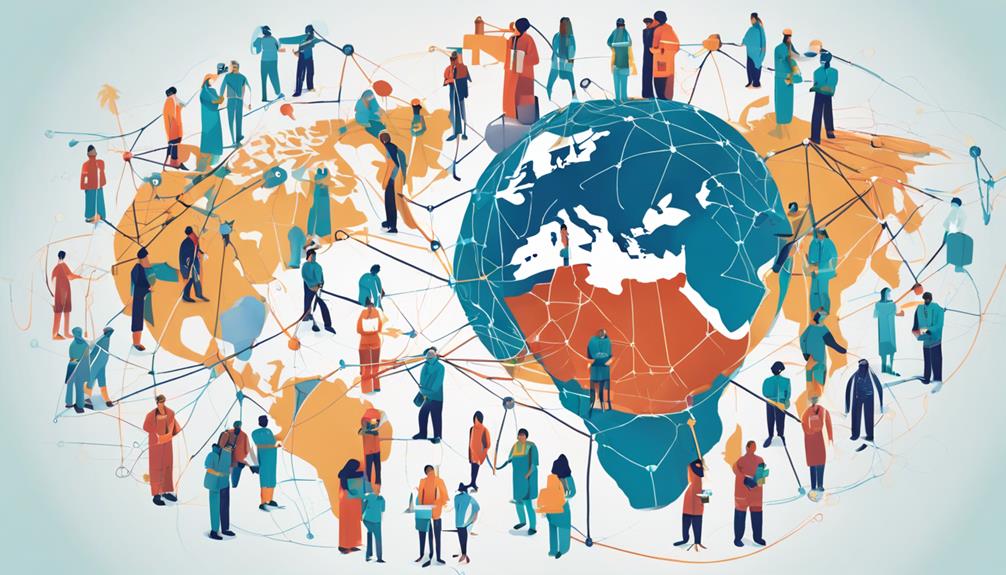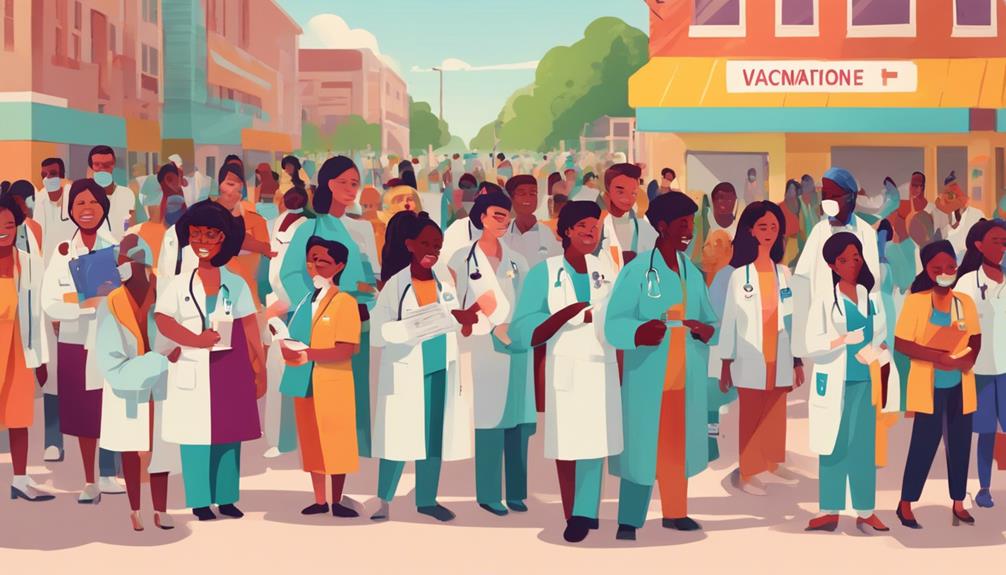The WHO Health Emergencies Programme (WHE) focuses on strengthening global health security in response to emerging health threats like pandemics. Established in 2016 after the Ebola outbreak, WHE enhances preparedness through training, risk assessment, and community engagement. It emphasizes partnerships among governments, NGOs, and organizations to facilitate resource sharing and swift action. The program employs strategic frameworks that prioritize vulnerable areas and leverage data for informed decisions. Lessons from past outbreaks underscore the importance of collaboration and efficient resource mobilization. To grasp the depth of these strategies and their impacts, you may find it insightful to explore further aspects of the program.
Overview of WHE

The World Health Organization's Health Emergencies Programme (WHE) is designed to swiftly respond to health crises, ensuring that countries are better equipped to manage outbreaks and protect public health. Established in 2016, WHE emerged from the lessons learned during the Ebola outbreak, highlighting a vital need for a more coordinated global response.
You'll notice that its history reflects a commitment to enhancing preparedness and resilience against future health threats.
However, the WHE faces significant challenges. One major obstacle is the ever-evolving nature of pathogens, which can outpace existing response strategies. For instance, emerging diseases like COVID-19 demonstrate the need for rapid adaptation in protocols and approaches.
Additionally, resource allocation remains a contentious issue; many countries struggle to secure funding for robust health infrastructures.
Moreover, WHE encounters difficulties in fostering collaboration among various stakeholders, including governments, NGOs, and local communities. You might find that effective communication and coordination are essential for successful interventions, yet they often fall short.
To conclude, while WHE is pivotal in addressing health emergencies, understanding its history and challenges is essential for appreciating its role in global health security.
Key Objectives
WHE's key objectives focus on strengthening global health security by enhancing preparedness, response capabilities, and coordination among various stakeholders during health emergencies. One critical aspect of these objectives is effective risk assessment. By identifying potential health threats early, you can prioritize resources and implement timely interventions, ultimately reducing the impact of outbreaks.
Capacity building is another essential goal. WHE emphasizes developing the skills and infrastructure necessary for countries to respond effectively to health crises. This involves training health professionals, enhancing laboratory capabilities, and guaranteeing robust surveillance systems are in place. By empowering nations, you promote resilience and foster self-reliance in managing health emergencies.
Moreover, WHE aims to improve coordination among governments, international organizations, and non-governmental entities. This collaboration guarantees a unified approach to health emergencies, facilitating the sharing of data, resources, and expertise. By working together, you enhance overall response efforts and ensure that best practices are implemented across borders.
Major Initiatives

In understanding the WHO Health Emergencies Programme, you'll see two major initiatives that stand out: the Emergency Response Framework and Global Health Partnerships.
These initiatives are designed to enhance the effectiveness of health responses during crises and foster collaboration among nations and organizations.
Emergency Response Framework
Focusing on rapid deployment and strategic coordination, the Emergency Response Framework outlines major initiatives designed to effectively manage health emergencies globally. This framework emphasizes the importance of emergency preparedness and crisis management as fundamental components in mitigating health threats. For you, understanding these initiatives is vital for recognizing how health systems can respond to crises efficiently.
One key initiative involves the establishment of a robust surveillance system. This system enables timely detection of health threats, allowing for immediate action to prevent escalation.
Additionally, the framework promotes training programs aimed at enhancing the skills of health professionals in emergency response. These programs guarantee that personnel are well-equipped to manage crises effectively.
Another significant aspect is the integration of data management systems, which provide real-time information to guide decision-making during emergencies. This integration fosters collaboration among various stakeholders, guaranteeing that resources are allocated effectively.
Global Health Partnerships
Building on the importance of rapid response outlined in the Emergency Response Framework, global health partnerships play a pivotal role in enhancing collective efforts to address health emergencies through collaboration and resource sharing.
These initiatives foster health diplomacy, allowing countries to work together in tackling shared challenges. By pooling resources and expertise, they create robust networks that can swiftly respond to outbreaks and other health crises.
One significant example is the COVAX initiative, which aims to guarantee vaccine equity by providing access to COVID-19 vaccines for low- and middle-income countries. This initiative has highlighted the importance of collaboration between governments, international organizations, and private sectors to eliminate disparities in vaccine distribution.
Moreover, partnerships like the Global Fund and Gavi have demonstrated that effective health diplomacy can mobilize funding and technical support to combat diseases such as HIV/AIDS, tuberculosis, and malaria. Through these collaborations, countries can build stronger health systems, improve surveillance, and enhance preparedness for future emergencies.
Ultimately, global health partnerships are essential for optimizing responses to health emergencies, making sure no one is left behind in the pursuit of equitable health solutions.
Global Response Framework
The Global Response Framework outlines strategic approaches for nations to coordinate their efforts effectively in managing health emergencies and enhancing resilience against future outbreaks.
You'll find that this framework emphasizes the importance of global health collaboration and emergency preparedness, ensuring that countries can respond swiftly to crises like pandemics or natural disasters.
By implementing standardized protocols and sharing best practices, nations can improve their readiness for health emergencies. The framework encourages the development of robust surveillance systems that monitor disease outbreaks in real-time, allowing for timely interventions. Additionally, it highlights the need for resource allocation and training, ensuring healthcare workers are equipped with the skills necessary to tackle emergencies efficiently.
Another vital aspect is the integration of community engagement, which fosters trust and supports health messaging during crises.
You'll see that this holistic approach not only addresses immediate threats but also builds long-term resilience. Ultimately, by adhering to the Global Response Framework, countries can create a more effective and unified response to health emergencies, reinforcing the principle that preparedness today safeguards global health tomorrow.
Collaborations and Partnerships

Collaborations and partnerships among nations, organizations, and communities are vital in amplifying the effectiveness of health emergency responses.
You'll find that strong stakeholder engagement plays a key role in these collaborations. Engaging diverse stakeholders—including governmental bodies, NGOs, and local communities—guarantees that varied perspectives and resources are harnessed effectively. This collective approach enables a more thorough understanding of the challenges faced during health emergencies.
Moreover, resource mobilization becomes markedly more efficient when multiple entities work together. By pooling resources, whether financial, human, or technological, partners can address gaps that individual organizations might struggle to fill alone. For instance, during outbreaks, timely sharing of information and resources can lead to quicker responses and more effective interventions.
The synergy created through these partnerships not only enhances immediate response capabilities but also builds resilience for future emergencies. By fostering a culture of collaboration, you can guarantee a more coordinated and impactful approach to health emergencies, ultimately leading to better health outcomes for affected populations.
Case Studies
In examining case studies within the WHO Health Emergencies Programme, you'll find effective response strategies that have proven successful in real-world situations.
These cases not only highlight what works but also reveal valuable lessons learned, helping to refine future approaches.
Effective Response Strategies
How can effective response strategies, demonstrated through various case studies, enhance the resilience of health systems during emergencies?
By focusing on community engagement and strategic resource allocation, you can greatly improve the outcomes of health interventions. For instance, during the Ebola outbreak, local communities were pivotal in disseminating information and fostering trust, which directly influenced the effectiveness of response efforts. Engaging community leaders helped tailor health messages to cultural contexts, allowing for better compliance with health advisories.
Moreover, successful case studies highlight the importance of resource allocation. By prioritizing the distribution of essential supplies and medical personnel to high-risk areas, health systems can mitigate the impact of emergencies. The COVID-19 pandemic showed that countries with pre-established frameworks for rapid resource allocation could respond more effectively, reducing morbidity and mortality rates.
Lessons Learned From Cases
Case studies from recent health emergencies reveal vital insights that can greatly strengthen future response efforts and enhance system resilience. By analyzing these case studies, you can identify key elements that contribute to effective public health strategies and crisis management.
For instance, the response to the Ebola outbreak highlighted the importance of rapid information sharing among health agencies, which considerably reduced the spread of the virus.
Moreover, lessons from the COVID-19 pandemic emphasize the need for robust surveillance systems and the ability to adapt communication strategies to the public. Engaging communities in decision-making processes fosters trust, which is essential during health crises.
Additionally, case studies demonstrate that pre-established partnerships between governments, NGOs, and international organizations can facilitate quicker mobilization of resources.
You'll also find that training healthcare workers in crisis management improves local response capabilities.
These findings underscore that addressing vulnerabilities in health systems and investing in preparedness can mitigate the impact of future emergencies. Ultimately, integrating these lessons into public health frameworks will enhance resilience and guarantee a more effective response when crises arise.
Future Directions

The WHO Health Emergencies Programme is poised to enhance its response strategies by integrating advanced technologies and data analytics to predict and manage future health crises more effectively. By employing machine learning algorithms and real-time data collection, you can identify emerging threats and mobilize resources more rapidly. This technology integration is vital for developing proactive measures, allowing for timely interventions and reducing the overall impact of health emergencies.
Additionally, the programme will focus on sustainability strategies that guarantee resilience in health systems. This means fostering local capacities and improving community engagement to create a robust response framework. You'll notice an emphasis on collaboration with various stakeholders, including governments, NGOs, and the private sector, to align efforts and share resources.
Investing in training and education will also be a priority, empowering healthcare workers to utilize these advanced tools effectively. By prioritizing sustainability and technology, the WHO Health Emergencies Programme aims not only to respond to crises but to build a future-ready health ecosystem. This proactive approach will enable you to tackle health emergencies with greater efficiency, ultimately saving lives and resources in the process.
Conclusion
In summary, the WHO Health Emergencies Programme plays an essential role in strengthening global health security.
By focusing on preparedness, response, and recovery, it addresses the multifaceted challenges posed by health emergencies.
The collaborative efforts with various partners and the implementation of evidence-based initiatives enhance community resilience.
As you look ahead, it's clear that continued investment in this program is critical for safeguarding public health and effectively managing future health crises.
